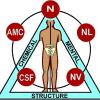CYBERMED LIFE - ORGANIC & NATURAL LIVING
CYBERMED LIFE - ORGANIC & NATURAL LIVING
 Applied kinesiology (AK) is a technique in alternative medicine claimed to be able to diagnose illness or choose treatment by testing muscles for strength and weakness.
Applied kinesiology (AK) is a technique in alternative medicine claimed to be able to diagnose illness or choose treatment by testing muscles for strength and weakness.
According to their guidelines on allergy diagnostic testing, the American College of Allergy, Asthma and Immunology stated there is "no evidence of diagnostic validity" of applied kinesiology. Another study has shown that, as an evaluative method, AK "is no more useful than random guessing", and the American Cancer Society has said that "scientific evidence does not support the claim that applied kinesiology can diagnose or treat cancer or other illness".